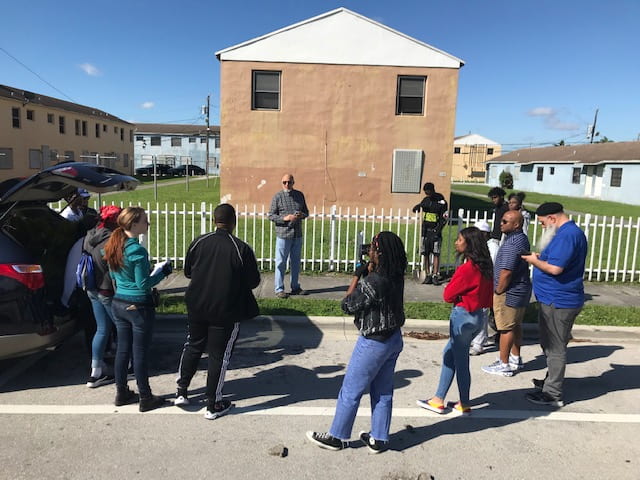Renee Darbonne
Contributing Writer
On Nov. 16, the Broward College’s Social Science Club at North Campus took a trip down south to Miami’s Liberty City to visit the 12th Ave. Segregation Wall. It was a live lesson about the history of segregation in South Florida that was facilitated by the club’s advisor, Dr. Mirsad Krijestorac, Assistant Professor of Political Science.
The club was also joined by Dr. Todd E. Bernhardt, the Academic Dean of the Social and Behavioral Sciences & Human Services Department at Broward College North Campus, and Wayne Rawlins, the lead facilitator of South Florida’s Reentry Task Force, a group that advocates for Amendment 4 and returning citizen’s voting rights.
Many will walk past what looks like an unassuming concrete slab edging the sidewalk hidden underneath the brush and shrubbery of weeds on Martin Luther King, Jr. Boulevard. However, few will know that they are passing by remnants of the wall and know how integral it is to the history of segregation in America and South Florida.
It was under Franklin Delano Roosevelt’s New Deal that the second housing project in America was built, Liberty Square. There was immensely negative reaction from the adjacent white neighborhoods in even having to look at their “negro” neighbors, resulting in many of them relocating to South Miami so as to stop the white neighbors from seeing “negroes” as stated by Mr. Rawlins.
This dissatisfaction manifested itself into an 8-foot wall erected along Liberty Square in the late 1930s, to separate the upcoming black communities from the pre-existing white neighborhoods.

Strangely, there were no architectural plans or approval for the wall and although it remained standing tall through the 1960s, who approved, or when it was approved for construction and later demolished remains unknown as there is no official city records or blueprints of it. This ironically symbolizes how many in the South Florida community neglect or refuse to care about this dark but vital part of the history of the Sunshine State.
Once there, the club met with students from the Miami-Dade Correctional Juvenile Facility to “beautify” the wall. Armed with shovels, trash bags and gardening tools, the students worked together by removing the weeds and overgrowth from along the wall and planting Florida native plants.
Brenda Jeudy, a member of the club, commented afterwards, “I think a lot of people should go and see it (the wall) and contribute to the beautification projects that they are actually doing to keep this part of history alive because there are no records of it, so if we tear it down completely the generations to come wouldn’t know about it.”
Katherine Thompson, the president of the Social Science Club, also said that the trip was surreal and, as someone who grew up in a fundamentally different part of South Florida, she was happy that the club was able to partake in the effort of keeping the history behind the wall alive.
“As someone who participated in the trip, I must say I agree with the members of the club regarding the importance of keeping others informed about this part of South Florida’s history and making efforts to turn the community into a better place for its residents who still experience the consequences of the red-lining of districts even to this day.
The trip was a success by all accounts, as Dr. Krijestorac said.
“The purpose of the trip was accomplished just by bringing students here to see it (the wall). Just hearing about this in the classroom, students struggle to visualize this happening in their own communities, and this trip makes this history alive.”
The Social Science Club said they would make this visit a semesterly project to ensure the maintenance of the plants, along with the promised support of the SBSHS department of North Campus, as stated by Dr. Bernhardt.
They also hope to bring more Broward College students along with them in the future and collaborate their efforts with other clubs across all the campuses.
If anyone is interested in participating in this project next semester, contact the advisor of the North Campus Social Science Club, Dr. Mirsad Krijestorac, for more information at mkrijest@broward.edu.
darbr4@mail.broward.edu